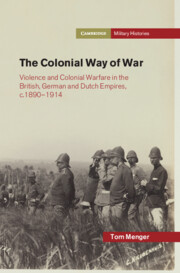Refine search
Actions for selected content:
618 results

Afro-Mexican Lives in the Long Nineteenth Century
- Slavery, Freedom, and the Writing of History
-
- Published online:
- 20 November 2025
- Print publication:
- 04 December 2025
From Warriors to Servants: Romans 13 and a Theology of Policing
-
- Journal:
- Journal of Law and Religion / Volume 39 / Issue 3 / September 2024
- Published online by Cambridge University Press:
- 19 November 2025, pp. 328-376
-
- Article
-
- You have access
- Open access
- HTML
- Export citation
Brassage on Film: Late Colonialism in French Africa and Race-Making in Postcolonial France in the Work of Jean Rouch
-
- Journal:
- Itinerario , First View
- Published online by Cambridge University Press:
- 10 November 2025, pp. 1-17
-
- Article
-
- You have access
- Open access
- HTML
- Export citation
Too Woke or Not Woke Enough? Racial Awareness in the Church of England
-
- Journal:
- Journal of Anglican Studies , First View
- Published online by Cambridge University Press:
- 20 October 2025, pp. 1-23
-
- Article
-
- You have access
- Open access
- HTML
- Export citation
Racial Whitening as a Global ‘Innovation’: Race in the First Brazilian Republic (1889-1930)
-
- Journal:
- Du Bois Review: Social Science Research on Race , First View
- Published online by Cambridge University Press:
- 20 October 2025, pp. 1-17
-
- Article
-
- You have access
- Open access
- HTML
- Export citation
Notebook
-
- Book:
- The Epistemology of the Secret
- Published online:
- 23 July 2025
- Print publication:
- 09 October 2025, pp 145-154
-
- Chapter
- Export citation
2 - Secret-Keepers and Mythmakers
- from Part I - Struggle to Conceal
-
- Book:
- Curating the Colonial Past
- Published online:
- 12 September 2025
- Print publication:
- 02 October 2025, pp 58-86
-
- Chapter
- Export citation
13 - Becoming a Witness
- from Part III - Witnesses
-
-
- Book:
- The Cambridge Companion to American Prison Writing and Mass Incarceration
- Published online:
- 02 October 2025
- Print publication:
- 02 October 2025, pp 207-222
-
- Chapter
- Export citation
“Let Perpetual Light Shine upon Them”: Forgetting and Remembering Segregated Catholic Cemeteries
-
- Journal:
- American Antiquity , First View
- Published online by Cambridge University Press:
- 01 October 2025, pp. 1-24
-
- Article
-
- You have access
- Open access
- HTML
- Export citation

My Own Past
- Afrodescendant Contributions to Cuban Art
-
- Published online:
- 30 September 2025
- Print publication:
- 18 September 2025
Six Pipelines: Invigorating Race in Canadian Political Science
-
- Journal:
- Canadian Journal of Political Science/Revue canadienne de science politique , First View
- Published online by Cambridge University Press:
- 25 September 2025, pp. 1-29
-
- Article
-
- You have access
- Open access
- HTML
- Export citation
Chapter 9 - From Political to Migration-Based Conditionality in EU Development Policy
- from Part I - Law
-
-
- Book:
- Colonialism and the EU Legal Order
- Published online:
- 14 October 2025
- Print publication:
- 18 September 2025, pp 202-228
-
- Chapter
-
- You have access
- Open access
- HTML
- Export citation
Preface
-
- Book:
- My Own Past
- Published online:
- 30 September 2025
- Print publication:
- 18 September 2025, pp xxv-xxviii
-
- Chapter
- Export citation
Structural racism and suicide risk among Black youth: A systematic review
-
- Journal:
- Development and Psychopathology , First View
- Published online by Cambridge University Press:
- 15 September 2025, pp. 1-15
-
- Article
-
- You have access
- Open access
- HTML
- Export citation
A Harm Reduction Approach to Attitudinal Racism
-
- Journal:
- Canadian Journal of Philosophy , FirstView
- Published online by Cambridge University Press:
- 09 September 2025, pp. 1-25
-
- Article
-
- You have access
- Open access
- HTML
- Export citation

The Colonial Way of War
- Violence and Colonial Warfare in the British, German and Dutch Empires, c.1890–1914
-
- Published online:
- 04 September 2025
- Print publication:
- 21 August 2025
Making Violators: Employers and African Workers in Colonial Dakar, 1918–43
-
- Journal:
- The Journal of African History / Volume 66 / 2025
- Published online by Cambridge University Press:
- 27 August 2025, e9
-
- Article
-
- You have access
- Open access
- HTML
- Export citation
A racial reckoning? racial attitudes in the wake of the murder of George Floyd
-
- Journal:
- Political Science Research and Methods , First View
- Published online by Cambridge University Press:
- 27 August 2025, pp. 1-17
-
- Article
-
- You have access
- Open access
- HTML
- Export citation
Chapter 4 - Disgust and Mental Detection
-
- Book:
- Manufacturing Dissent
- Published online:
- 03 October 2025
- Print publication:
- 21 August 2025, pp 123-165
-
- Chapter
- Export citation
5 - Practices of Violence
-
- Book:
- The Colonial Way of War
- Published online:
- 04 September 2025
- Print publication:
- 21 August 2025, pp 239-305
-
- Chapter
- Export citation
